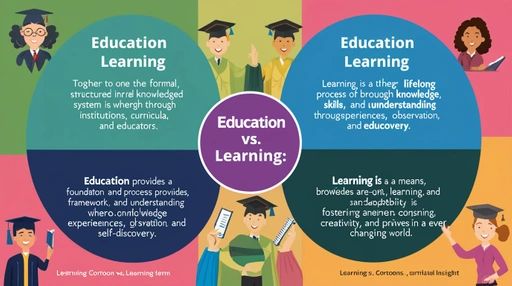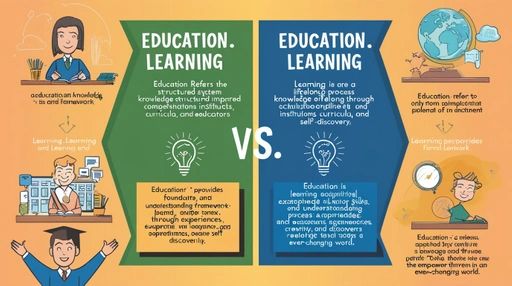Education vs. Learning: A Comparative Insight, Education and learning are often used interchangeably, yet they represent distinct concepts. Both play vital roles in shaping individuals and societies, but their approaches, scope, and outcomes differ significantly. Understanding the distinction between the two can enhance our appreciation of how knowledge and personal growth are cultivated.
Defining Education
Education refers to a structured system of imparting knowledge, skills, and values, typically in institutional settings like schools, colleges, and universities. It follows a curriculum designed to address specific learning goals and societal needs. Education often involves formal instruction by educators who guide students through predefined syllabi.
The core attributes of education include:
- Formality: It is systematic and follows structured methods.
- Certification: Education culminates in qualifications such as diplomas or degrees, often serving as benchmarks for career advancement.
- Standardization: Curricula are designed to ensure consistency in knowledge dissemination.
Education focuses on developing intellectual abilities and preparing individuals for professional roles. However, it may sometimes lack flexibility, emphasizing rote learning over critical thinking and creativity.
Understanding Learning
Learning, on the other hand, is a broader and more dynamic process. It is the act of acquiring knowledge, skills, attitudes, or values through experience, observation, practice, or instruction. Learning is not confined to formal settings; it can occur anywhere and at any time.
The defining characteristics of learning include:
- Lifelong Process: Learning continues throughout life and adapts to changing circumstances.
- Informality: It can occur without structured frameworks, often driven by curiosity or necessity.
- Personalization: Learning aligns with an individual’s interests, pace, and preferred methods.

Learning emphasizes understanding, application, and the ability to adapt to new challenges. It nurtures creativity, critical thinking, and problem-solving skills, making it indispensable in personal and professional growth.
Key Differences Between Education and Learning
| Aspect | Education | Learning |
|---|---|---|
| Scope | Formal and structured; limited to institutions | Informal and unstructured; occurs everywhere |
| Approach | Teacher-driven, curriculum-focused | Self-driven, experience-focused |
| Goal | Knowledge acquisition for certification | Skill development and adaptability |
| Duration | Time-bound (e.g., school years) | Lifelong |
| Flexibility | Limited by system requirements | Highly flexible |
The Interplay Between Education and Learning
While education and learning are distinct, they are deeply interconnected. Education provides a foundation for learning by introducing individuals to various fields of knowledge. For instance, formal education teaches basic literacy and numeracy, essential skills that empower individuals to learn independently.
However, true learning often extends beyond the boundaries of formal education. A student may learn programming through online tutorials or develop leadership skills through practical experiences, neither of which may be part of a formal curriculum.
Challenges in Education and Learning
1. Overemphasis on Formality in Education
Modern education systems sometimes prioritize grades and certification over meaningful understanding, leading to superficial knowledge retention.
2. Inequality in Access
Educational opportunities are not equally distributed globally. Socioeconomic barriers often limit access to quality education, thereby hindering learning potential.
3. Resistance to Lifelong Learning
Some individuals view learning as limited to school years, neglecting the importance of continuous self-improvement.
Balancing Education and Learning
To maximize human potential, a balance between education and learning is essential. Here are some strategies to achieve this equilibrium:
- Promote Critical Thinking: Education systems should encourage students to question, analyze, and synthesize information rather than merely memorizing facts.
- Integrate Real-World Learning: Schools and universities can incorporate experiential learning, such as internships or community projects, to connect academic knowledge with practical applications.
- Encourage Lifelong Learning: Individuals should cultivate habits like reading, exploring new interests, or attending workshops to continue learning beyond formal education.
- Leverage Technology: Online platforms and e-learning tools provide opportunities to learn skills and knowledge that formal education may not cover.
Conclusion
Education and learning are not opposing forces but complementary processes. Education lays the groundwork, offering structured knowledge and skills, while learning expands horizons, fostering growth through diverse experiences. A society that values both will not only produce competent professionals but also critical thinkers, creative problem-solvers, and lifelong learners. Embracing this synergy is essential for personal fulfillment and societal progress.

4 thoughts on “Education vs. Learning: A Comparative Insight”
Comments are closed.